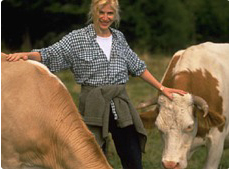The Case for Grass-fed Beef
 Over the last few decades, shrinking margins, supermarket demands and to a certain extent fashion has led farmers to move over to bigger, continental breeds of beef cattle. To fatten them successfully requires a diet much more cereal based than was previously the case with native breeds. This was in large part made possible by the low price of nitrogen fertiliser, which allowed the production of feed wheat at affordable prices.
Over the last few decades, shrinking margins, supermarket demands and to a certain extent fashion has led farmers to move over to bigger, continental breeds of beef cattle. To fatten them successfully requires a diet much more cereal based than was previously the case with native breeds. This was in large part made possible by the low price of nitrogen fertiliser, which allowed the production of feed wheat at affordable prices.
All that has now changed. Nitrogen fertilisers are no longer cheap and the manufacturing process uses very large amounts of natural gas (over 100,000 litres to make 1 ton of ammonia). The huge emissions of greenhouse gases and pollutants arising from their use now make them a target for legislation, as they account for 47% of the total energy consumption of UK agriculture and most are imported, adding further transport emissions. They also acidify lighter soils and to neutralise this acidity with lime creates further emissions of 400kgs of CO2 per ton of lime applied. On 100 hectares of acid land, up to 750 tons of lime will be required, leading to a further release of 300 tons of CO2. If Britain is serious about its commitment to the Kyoto Treaty and successors, some radical solutions must be found.
One solution is for beef farmers to move towards producing beef cattle using only grass, hay and silage as feed. In order to do this more effectively it will be necessary to re-introduce traditional British cattle breeds that can perform this feat. They are smaller animals than those currently in vogue, but are hardy, easily managed and produce meat of the highest quality. The fashion for lean meat, without the “marbling” (and taste) of the native breeds was brought about by the perceived need to lower cholesterol. Ironically, this was before we discovered that grass-fed beef is much higher in Omega 3 than meat from animals fed on cereals. At agricultural shows this year it was encouraging to see so many traditional breeds represented. A sign of the times perhaps.
This is all very well, but years of intensive grazing have taken their toll on the land. Since World War 2, the levels of essential mineral nutrients in our soils have declined by 60%. The result is that it has become harder to provide total feed requirement for livestock without resorting to the use of manufactured feeds and supplementary minerals, adding significantly to the cost of production.
Field Science has developed the means to solve this problem. The soil is first analysed to assess the deficiencies and imbalances of all the vital, nutritional minerals and the soil is then corrected using a tailor-made mineral dressing for that particular land. The result optimises the nutrient uptake into grass and crops, reducing the need for fertilisers and feed minerals. Cattle grow well on this improved land, as our customers can testify.
